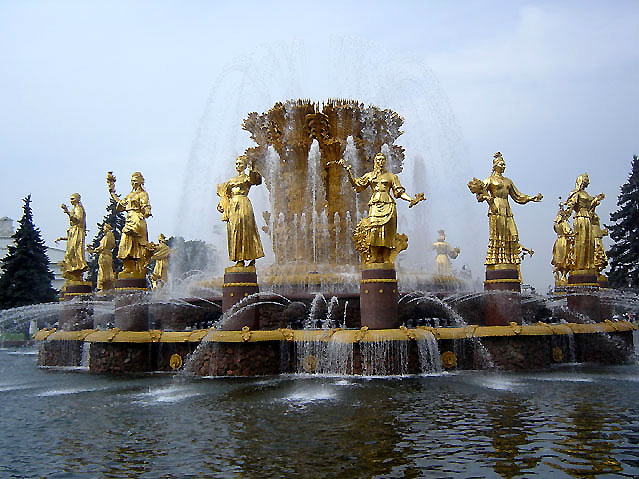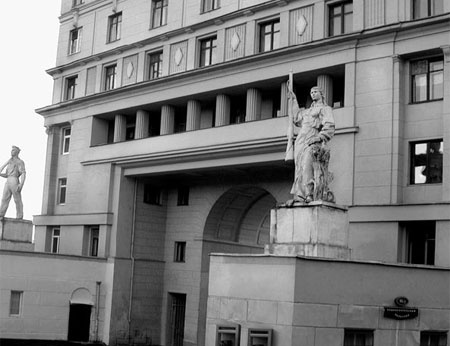
Fantasies of an Insane Confectioner
 In
the Soviet times, the architecture of the Stalin period, a sort of
“the grand style” of totalitarianism, was nicknamed “fantasies
of an insane confectioner”. Looking at the bizarre, cyclopean
architectural creations of the Stalin era, their mammoth size,
overabundance of decorative elements, you get a feeling you are
looking at a cross between a Babylonian ziggurat and an enormously
huge cake.
In
the Soviet times, the architecture of the Stalin period, a sort of
“the grand style” of totalitarianism, was nicknamed “fantasies
of an insane confectioner”. Looking at the bizarre, cyclopean
architectural creations of the Stalin era, their mammoth size,
overabundance of decorative elements, you get a feeling you are
looking at a cross between a Babylonian ziggurat and an enormously
huge cake.

The Stalinist edifices also reflected the very spirit of the totalitarian regimes but we must give credit to the architects who designed them for their skillful rendering the spirit of totalitarianism in architecture. Standing close to these monstrous architectural creations, you feel dwarfed by gigantic columns, huge statues of the heroes of the totalitarian myths, flamboyant moldings, you feel your insignificance, you feel oppressed and belittled by the might of the power that created these edifices. The idea is not so new, after all. Back in ancient Egypt, Babylonia and China, great pyramids, ziggurats and walls were creations inspired by the same sentiment — to dwarf and belittle.
In the late thirties, Stalin’s “court architects” worked out plans of “total reconstruction of Soviet cities,” with Moscow “to be completely renovated” first. Reading those plans now, you get a feeling that the architects were criminally insane. There was a plan of demolishing a pearl of Russian architecture – St. Basil’s Cathedral – mainly because it hindered Stalin’s plans for massed parades and demonstrations on Red Square. It was only saved thanks to the courage of the architect Pyotr Baranovsky. When ordered to prepare the building for demolition, he refused categorically, and sent an extremely blunt telegram to the Kremlin. The Cathedral remained standing, and Baranovsky’s conservation efforts earned him five years in prison.
 In
Kyiv, these plans called for the destruction of the most ancient and
most revered architectural landmarks, Holy Sophia Cathedral and St.
Michael’s Golden-Domed Monastery among them. Upon the land thus
“cleared” a number of communist party and government buildings,
“Stalinist temples,” were to be erected. The authorities began
putting this plan into action by razing St Michael’s to the ground.
A huge building was built close by and it housed the central
committee of the communist youth organization (now it is headquarters
of the Ministry for Foreign Affairs).
In
Kyiv, these plans called for the destruction of the most ancient and
most revered architectural landmarks, Holy Sophia Cathedral and St.
Michael’s Golden-Domed Monastery among them. Upon the land thus
“cleared” a number of communist party and government buildings,
“Stalinist temples,” were to be erected. The authorities began
putting this plan into action by razing St Michael’s to the ground.
A huge building was built close by and it housed the central
committee of the communist youth organization (now it is headquarters
of the Ministry for Foreign Affairs).
They say it was Lavrentiy Beriya, top KGB boss, who saved the ancient architectural landmarks remaining in Kyiv from destruction. At the time when the demolitions began, he headed a department charged with providing security for the red elite. He ordered to halt the construction of other buildings in the vicinity of the ruined St Michael’s because he saw a certain danger in the fact that the government buildings would be clustered close together on top of one of Kyiv's hills. Analyzing the projects, he realized that escape routes from the top of that hill could be easily blocked. It alarmed him and the demolitions were halted, not because Beriya cared a bit for the culture of the past — he did not, but he cared for the safety of the red bosses.
